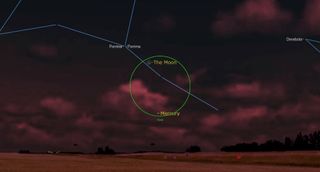Watch the young moon rise above Mercury tonight

See the young moon over Mercury in the evening sky just after sunset tonight (Aug. 29).
Mercury, the smallest and closest planet to the sun, and the crescent moon will appear close together in the lower part of the western night sky tonight. However, it will be more difficult to spot the duo for observers in the Northern Hemisphere than for those located south of the equator.
"From the Northern Hemisphere, the geometry is poor. Mercury is wide to the left of sunset but close to the horizon, giving you less than an hour to spot the fleet-footed planet before it, too, dips below the horizon," according to EarthSky.org.
Related: The brightest planets in August's night sky: How to see them (and when)
Observers can use the moon as a guide to spot Mercury, as the lighted portion of the crescent points to the low-lying planet. The crescent moon will shine a palm's width above (or 6 degrees to the celestial northeast) of Mercury, which has a magnitude of 0.23. The pair will be barely close enough to share the view in binoculars, according to geophysicist Chris Vaughan, amateur astronomer with SkySafari Software who oversees Space.com's Night Sky calendar.
Using binoculars, viewers can safely look near the horizon just after sunset as the sky begins to darken. Viewers will also be able to spot the stars Spica — brightest star in the constellation Virgo — and Arcturus, the brightest star in the northern half of the sky. These are the first stars to appear in the western sky as night falls. The bright double star Porrima will also appear to the moon's upper left as Mercury sinks out of sight in the darkening sky.

Looking for a telescope to see the moon? We recommend the Celestron Astro Fi 102 as the top pick in our best beginner's telescope guide.
But viewers in the Southern Hemisphere will have a better opportunity to view Mercury and the young moon.
Get the Space.com Newsletter
Breaking space news, the latest updates on rocket launches, skywatching events and more!
"Instead of ringing the horizon with the sun, the two will stand above the sun. This perpendicular alignment with the horizon gives you about two hours to spot Mercury before it sets," according to EarthSky.org. "You'll see Spica above Mercury and the moon, with Arcturus to the right."
By tomorrow night (Aug. 30), the moon will appear closer to the star Spica than to Mercury, as the planet gets ready to begin its next period of retrograde motion, or backward movement, across the night sky on Sept. 9.
You can check out our guide for the best binoculars to spot both the moon and Mercury in the night sky. If you're hoping to capture a good photo of the duo, or another upcoming skywatching event, check out our guide for best cameras for astrophotography and best lenses for astrophotography.
Follow Samantha Mathewson @Sam_Ashley13. Follow us on Twitter @Spacedotcom and on Facebook.
Join our Space Forums to keep talking space on the latest missions, night sky and more! And if you have a news tip, correction or comment, let us know at: community@space.com.

Samantha Mathewson joined Space.com as an intern in the summer of 2016. She received a B.A. in Journalism and Environmental Science at the University of New Haven, in Connecticut. Previously, her work has been published in Nature World News. When not writing or reading about science, Samantha enjoys traveling to new places and taking photos! You can follow her on Twitter @Sam_Ashley13.
